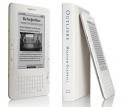By Allyson Dickman > Senior > Journalism > University of Maryland
 n four years, the average student will spend nearly $3,000 on textbooks. That’s enough for a down payment on a car, a trip to Europe or a flat-screen plasma TV. Incoming students may be able to save their book funds for just that, as E-readers could make textbooks cheap.
n four years, the average student will spend nearly $3,000 on textbooks. That’s enough for a down payment on a car, a trip to Europe or a flat-screen plasma TV. Incoming students may be able to save their book funds for just that, as E-readers could make textbooks cheap.
“I think [students] read prolifically,” said Dr. Charles Ginn, assistant professor of psychology at the University of Cincinnati. “But they’re reading in electronic formats. It’s what they grew up and are familiar with. ”E-readers, like the Kindle, Sony Reader and Nook, may not catch on to college pleasure readers soon, but it looks like E-readers will be the most convenient and cheapest form for textbooks.
Last year, Ginn conducted a study of 2,000 students comparing a $135 paper textbook and the $50 E-text option. Most students chose the E-text, and more underclassmen than upperclassmen chose the E-version. With the groundwork set through Google Books and Blackboard, Ginn believes e-textbooks are the future, and should cost no more than 30 percent of a paper version’s cost.
Steve Rosenbaum, a senior at SUNY Oneonta, would gladly transition to e-textbooks. “If you download them it saves printing costs and lines at the bookstore,” he said. “And it can have all your textbooks in one.” And the initial cost of the device, between $150 and $400, might not deter students since textbooks already run that high.
But there are still kinks. “Very little of what students have to read is available for Kindle,” said Barbara Fister, librarian and professor at Gustavus Adolphus College in Minnesota. “And the black and white screen means forget having your biology textbook available.” But E-reader companies are already addressing these issues in their new models.
“We’ll always have print books,” Ginn said. “But in the apartment of the graduate in the future, there may be one book case for books, when there were two or three in years past.



















